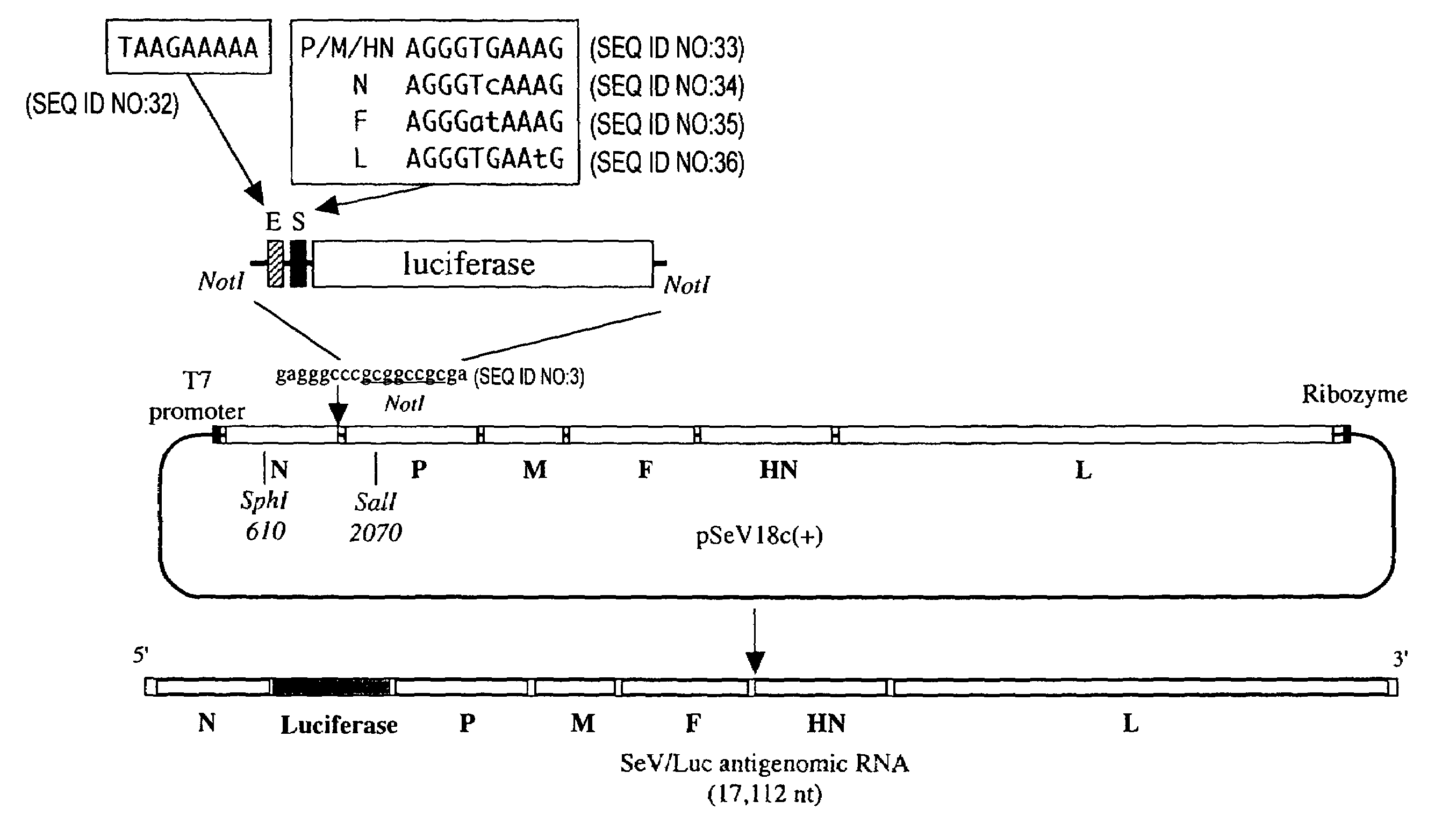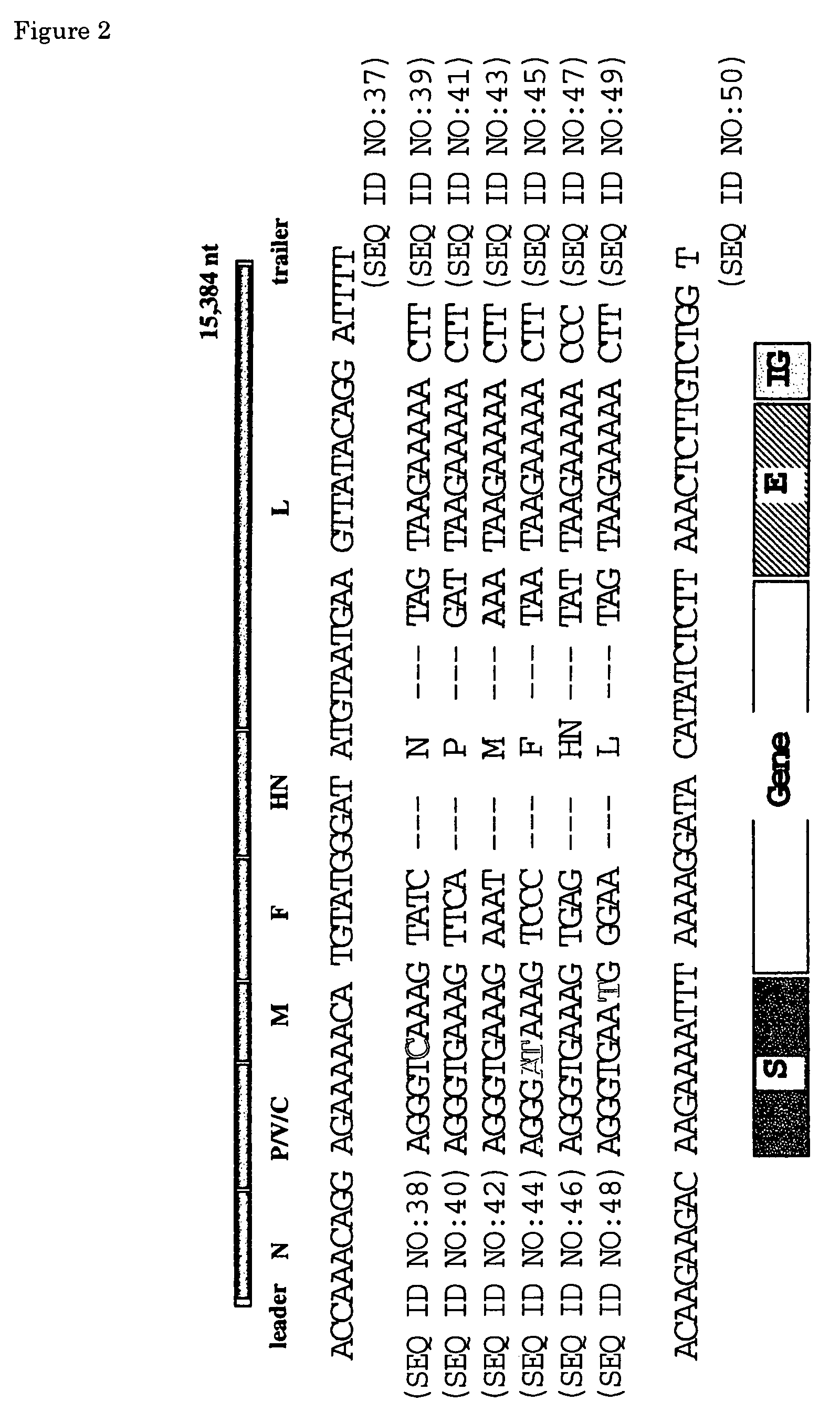Paramyxoviruses comprising modified transcription start sequence
a technology of paramyxovirus and transcription start sequence, which is applied in the direction of antibody medical ingredients, peptide sources, peptides, etc., can solve the problem that the effect of nucleotide substitution in the s sequence on transcription initiation cannot be accurately examined in the model template system, and achieve the effect of reducing the expression level of p gene and/or n gene, attenuating cytotoxicity, and minimizing the effect of virus replication ra
- Summary
- Abstract
- Description
- Claims
- Application Information
AI Technical Summary
Benefits of technology
Problems solved by technology
Method used
Image
Examples
example 1
Construction of Recombinant Viruses and Luciferase Assay
[0088]The nine nucleotides of the SeV E sequence are conserved exactly among all genes. On the other hand, there are minor differences in the nine nucleotides of S sequence. While S sequence of three (P, M and HN) of six genes are 3′-UCCCACUUU-5′, that of N, F and L gene are 3′-UCCCAgUUU-5′, 3′-UCCCuaUUU-5′, and 3′-UCCCACUUa-5′, respectively (FIG. 2). These minor differences are completely conserved in all strains of SeV regardless of the passage history, virulence and isolation strategy. To examine the role of these minor differences of S, the inventors created the four recombinant SeVs named SeV / SpLuc, SeV / SnLuc, SeV / SfLuc and SeV / SlLuc expressing the luciferase under the control of synthetic S sequence.
1-1. Creation of an Insertion Site After the N ORF
[0089]The plasmid pSeV(+) contained the cDNA copy of full-length SeV antigenome (Kato, A. et al., 1996, Genes to Cells 1: 569–579) was used as the starting material for plasmid...
example 2
Comparison of Primary Transcription Amounts from Recombinant Viruses
[0099]To see whether or not the differences of the expression amounts among four recombinant SeVs observed in Example 1 were primarily brought about at the level of transcription, but not in the replication process, CV1 cells infected with the recombinants were incubated in the presence of cycloheximide, which inhibits protein synthesis and hence, blocks viral replication requiring de novo viral protein synthesis. Under these conditions, only the viral primary transcription catalyzed by the virion-associated RNA polymerase is allowed.
[0100]In a similar manner as in Example 1, CV1 cells were infected with the recombinant viruses at an m.o.i. of 100, and the infected cells were incubated in the presence of 100 μg / ml cycloheximide (Sigma, St. Louis) for 12 h. The RNA in infected cells was prepared as described above, and the Northern hybridization was performed using the luciferase cDNA as the probe (FIG. 4, top). A di...
example 3
SeV Mutant Comprising a Modified S Sequence for the F Gene
[0103]The results described above suggested that there is a down-regulation of transcription at the F gene in the natural genome context of SeV. To investigate this, the inventors next created mutant SeV, SeV / mSf, whose S sequence of the F gene was replaced with that of the P / M / HN gene, as described below and compared its replication with that of the wild-type.
3-1. Mutagenesis to Modify the S Sequence of F Gene in Full-Length SeV cDNA
[0104]Two nucleotides substitutions were performed on the S sequence of F gene as follows. First, pSeV(+) was cleaved by BanIII at the SeV potions of 2088 and 5333 in SeV genome, and the resulting 3.4 Kb-fragment was recloned into the same restriction site of pBluescript KS(+) (Stratagene, La Jolla) to make a pB / BanIII. Then, site-directed mutagenesis by a PCR-mediated overlap primer extension method (Ho, S. N. et al., 1989, Gene 77:51–59) was performed as described above using synthesized two pr...
PUM
| Property | Measurement | Unit |
|---|---|---|
| concentrations | aaaaa | aaaaa |
| concentration | aaaaa | aaaaa |
| diameter | aaaaa | aaaaa |
Abstract
Description
Claims
Application Information
 Login to View More
Login to View More - R&D
- Intellectual Property
- Life Sciences
- Materials
- Tech Scout
- Unparalleled Data Quality
- Higher Quality Content
- 60% Fewer Hallucinations
Browse by: Latest US Patents, China's latest patents, Technical Efficacy Thesaurus, Application Domain, Technology Topic, Popular Technical Reports.
© 2025 PatSnap. All rights reserved.Legal|Privacy policy|Modern Slavery Act Transparency Statement|Sitemap|About US| Contact US: help@patsnap.com



